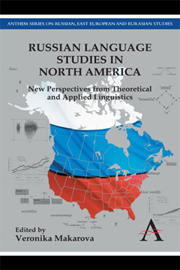Book contents
- Frontmatter
- Contents
- List of Tables and Figures
- Introduction
- Part One Language Structures and their Interface
- Part Two Applied Linguistic and Sociolinguistic Analysis
- 6 Communicative Language Teaching and Russian: The Current State of the Field
- 7 Low-Proficiency Heritage Speakers of Russian: Their Interlanguage System as a Basis for Fast Language (Re)Building
- 8 Superior Speakers or “Super” Russian: OPI Guidelines Revisited
- 9 Who Am I?: Cultural Identities among Russian-Speaking Immigrants of the Third (and Fourth?) Wave and their Effects on Language Attitudes
- 10 Russian Language History in Canada. Doukhobor Internal and External Migrations: Effects on Language Development and Structure
- Afterword
- Index
9 - Who Am I?: Cultural Identities among Russian-Speaking Immigrants of the Third (and Fourth?) Wave and their Effects on Language Attitudes
from Part Two - Applied Linguistic and Sociolinguistic Analysis
Published online by Cambridge University Press: 05 November 2012
- Frontmatter
- Contents
- List of Tables and Figures
- Introduction
- Part One Language Structures and their Interface
- Part Two Applied Linguistic and Sociolinguistic Analysis
- 6 Communicative Language Teaching and Russian: The Current State of the Field
- 7 Low-Proficiency Heritage Speakers of Russian: Their Interlanguage System as a Basis for Fast Language (Re)Building
- 8 Superior Speakers or “Super” Russian: OPI Guidelines Revisited
- 9 Who Am I?: Cultural Identities among Russian-Speaking Immigrants of the Third (and Fourth?) Wave and their Effects on Language Attitudes
- 10 Russian Language History in Canada. Doukhobor Internal and External Migrations: Effects on Language Development and Structure
- Afterword
- Index
Summary
Prologue
In the fall of 1985, when I was a graduate exchange student in Moscow, I had the most remarkable conversation with my best Russian friend, Maksim Kagan (a pseudonym to maintain confidentiality). It was Gorbachev's first year as secretary general of the Communist Party, but before he had formally introduced the policy of glasnost that ushered in the vast changes of the last twenty plus years. I was with Maksim, a 22-year-old in his final year at the university, on one of our weekend excursions about the city. I cannot recall what attraction we were visiting, but I do remember the topic of conversation: we had begun talking about Moses and Passover. However, it was not Maksim, the Russian Jew, explaining the basic history of Passover to me, but rather I, an American non-Jew, relating it to him. I was completely surprised that Maksim knew nothing about Passover except the word itself (“Pasxa,” which also means Easter and must therefore be preceded by the adjective “Jewish”) and the name of Moses (Moisej). Unlike some Soviet Jews at the time, he and his family had never concealed or denied their Jewishness in an attempt to assimilate; indeed, with their recognizably Jewish surname, it would have been impossible to do so. While fully acculturated into Soviet-Russian life and nonobservant religiously, they were proud of their heritage, felt group solidarity with other Jews, and were committed to combating expressions of anti-Semitism in the Soviet Union.
- Type
- Chapter
- Information
- Russian Language Studies in North AmericaNew Perspectives from Theoretical and Applied Linguistics, pp. 215 - 234Publisher: Anthem PressPrint publication year: 2012
- 1
- Cited by



